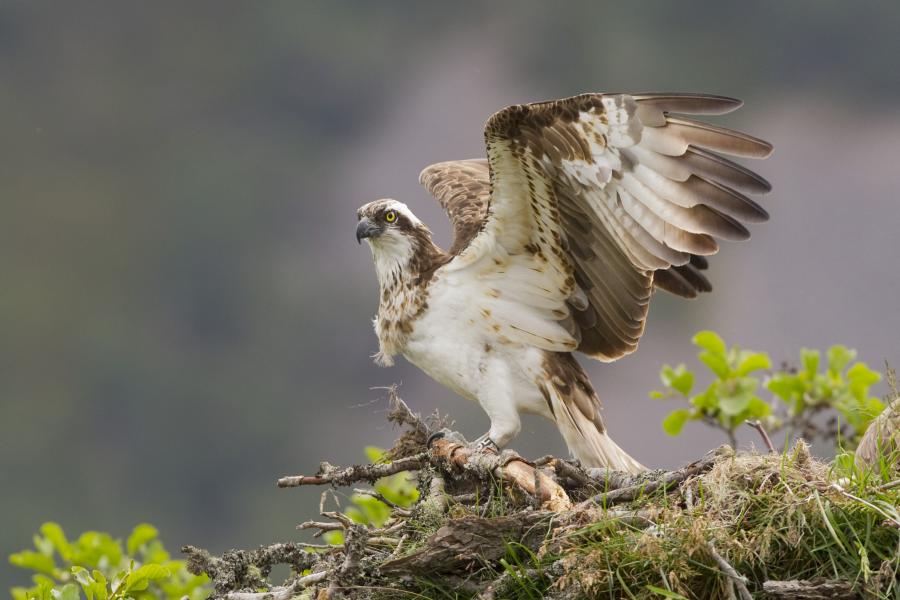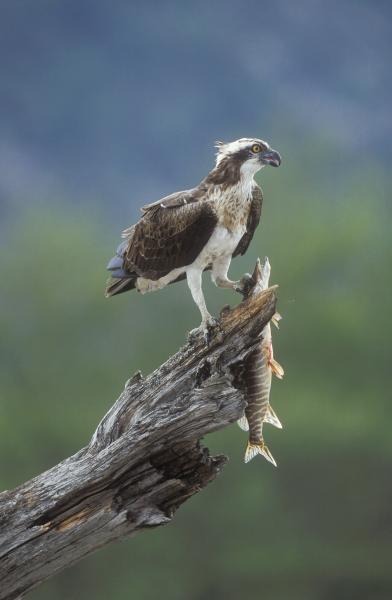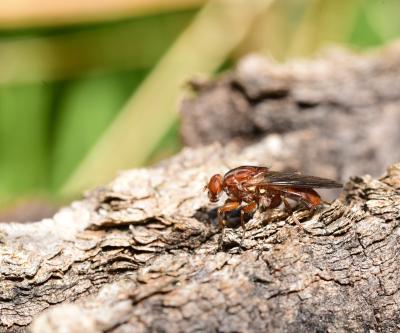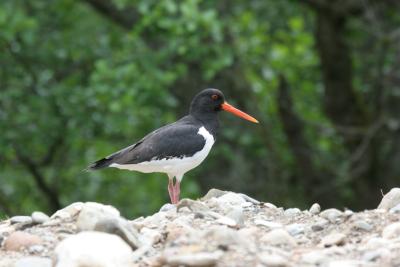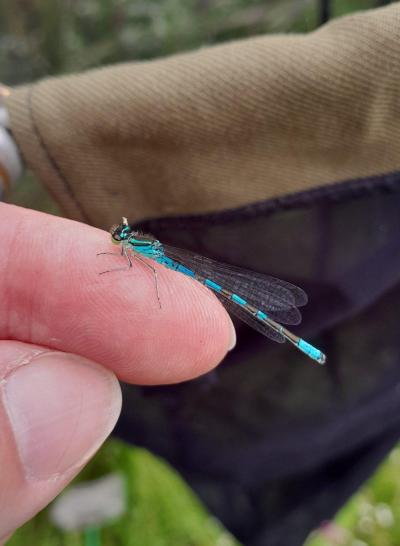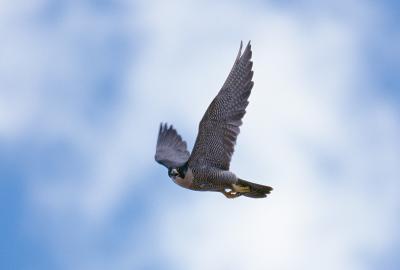Osprey
Pandion haliaetus
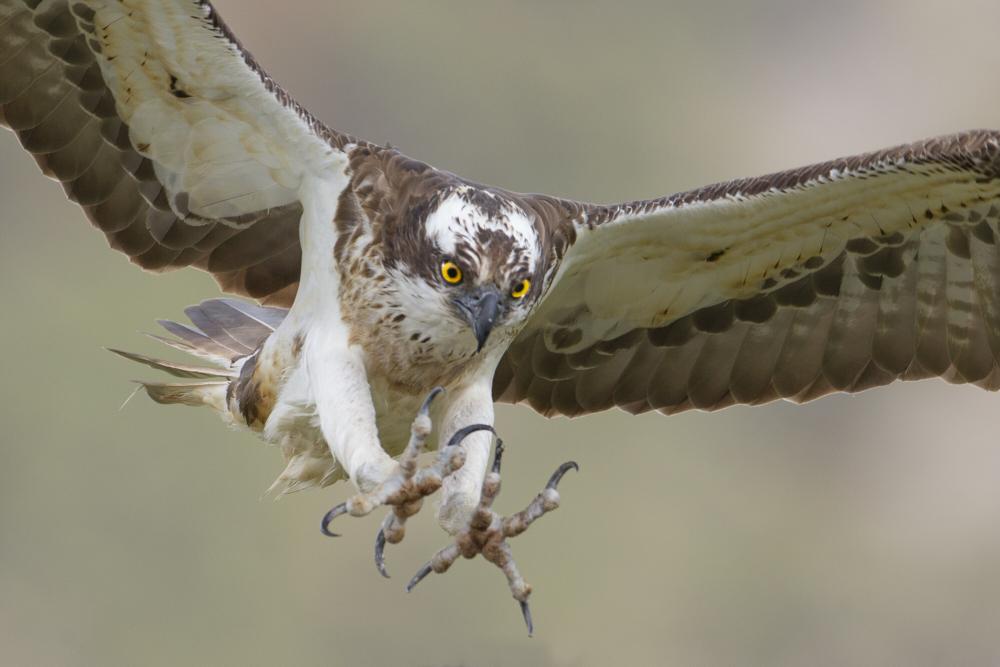
Evidence of ospreys in the UK dates back an incredible 12,000 years. They became extinct in Scotland in 1916, and the Cairngorms National Park has played an important part in their conservation success story since they returned to breed here in the 1950s.
Factsheet
Weight: 1.2 - 2kg
Lifespan: Nine years on average, but they can live much longer
Best time to spot: April to September
Ospreys have brown upperparts and white underparts, and pale grey legs. Their head is white, with a black beak and a dark brown band running back from their yellow eyes. Young birds, known as juveniles, have orange eyes and beige-tipped feathers. Females and males look similar, though females are larger than males and often have a necklace of brown feathers on their chest.
A fish-eating raptor with very long angled wings spanning over 1.5m, long curved talons and spine-covered toes, ospreys are perfectly built for catching their dinner. They cruise over lochs and rivers at a height of 10 to 90m and speeds of up to 50km per hour.
When they spot a fish - any will do, though trout are most common here - the osprey goes into a steep dive. Outstretching their talons at the last second, they grab their target from under the surface, sometimes submerging up to one metre, before transporting their meal to a suitable dining spot.
After going extinct in Scotland in 1916, ospreys returned to breed at Loch Garten in 1954. Five years later, the RSPB opened the Osprey Centre at Abernethy. It still exists today.
Did you know?
Evidence of ospreys in the UK dates back an incredible 12,000 years. They became extinct in Scotland in 1916, and the Cairngorms National Park has played an important part in their conservation success story since they returned to breed here in the 1950s.
Factsheet
Weight: 1.2 - 2kg
Lifespan: Nine years on average, but they can live much longer
Best time to spot: April to September
Ospreys have brown upperparts and white underparts, and pale grey legs. Their head is white, with a black beak and a dark brown band running back from their yellow eyes. Young birds, known as juveniles, have orange eyes and beige-tipped feathers. Females and males look similar, though females are larger than males and often have a necklace of brown feathers on their chest.
A fish-eating raptor with very long angled wings spanning over 1.5m, long curved talons and spine-covered toes, ospreys are perfectly built for catching their dinner. They cruise over lochs and rivers at a height of 10 to 90m and speeds of up to 50km per hour.
When they spot a fish - any will do, though trout are most common here - the osprey goes into a steep dive. Outstretching their talons at the last second, they grab their target from under the surface, sometimes submerging up to one metre, before transporting their meal to a suitable dining spot.
After going extinct in Scotland in 1916, ospreys returned to breed at Loch Garten in 1954. Five years later, the RSPB opened the Osprey Centre at Abernethy. It still exists today.
Did you know?
Ospreys come to Scotland to mate, returning to the same nest and partner year after year. They build messy nests of sticks, called eyries, on cliffs or high in trees near water, and add to it each breeding season. They’re also happy to use artificial nests, which has helped boost breeding numbers.
Once they’re ready to breed, osprey lay two to three eggs. These are surprisingly small - around the size of a duck egg. It’s mainly the female’s job to incubate them, while the male supplies her with food and defends the territory - though he will sit on the nest occasionally.
The chicks hatch after around 37 days and grow very quickly due to their high-protein diet. Both parents work hard during this phase: the male supplies the food to the female, who then shreds it into bitesize pieces and feeds it to the young. By five weeks old, they’re nearly fully grown. Eight or so weeks later, they can hunt alone and are ready to migrate.
The female osprey begins her migration alone, leaving the nest to fly up to 5,000km to her winter home. The male follows, leaving the chicks to make the journey alone. Nobody yet knows how these newly born youngsters know where to go - for the moment, it’s one of nature’s mysteries.






